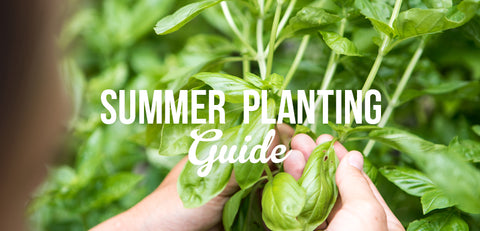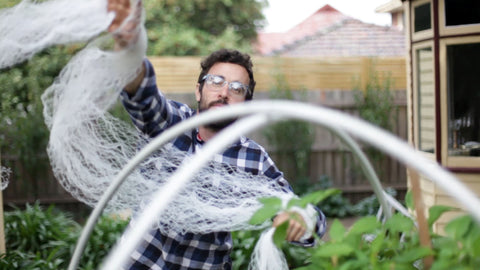The Summer Veggie Patch: What to Plant and How to Care

The Summer Planting Guide
Summer opens up new opportunities in the veggie patch that didn't exist while the erratic spring weather was doing its thing. Here are some of our favourite heat loving varieties that are primed to plant now;
1. Chillies: Heat is key for growing chilies and they require a hot, sun drenched space, preferably up against a heat reflecting wall that helps to collect extra rays of warmth. Those in cooler climates often produce the best chillies in hoop houses or any other insulated environment. However, do not let its infatuation with heat throw the basic demands of the plant. Even the toughest dudes need food and water to survive and the chilli is no exception. Chilli is known to be an aphrodisiac but to arrive there you have to be persistent. For a long time you may just burn your mouth and ruin your meals, but there will be a turning point when you begin to understand just how sexy a chilli can be.

2. Eggplant: Sometimes just by looking at a plant you can tell it copes well under duress, and the eggplant is a formidable looking vegetable- shinny and curvy in all of the right places. The plant’s tough leaves grow broadly, in effect shielding the soil beneath against overheating. The fruit itself has a dark, leathery skin - with annoying spikes on its neck - as if announcing inedibility. Surely when they first human ate an eggplant, their situation must have been quite bleak. When choosing what variety of eggplant to grow, let the timing of the season help you determine. Thinner varieties, such as Lebanese, develop earlier than larger fruit and also cope better earlier in the season, so choose accordingly.
3. Capsicum: A member from the solanacecae family that includes chilli, eggplant and tomato, capsicum is a crop that is best planted once the soil temperature has balanced out at a balmy 20oC and above. Much like its cousins, it is a heat loving variety that will prefer a sunny place in the patch with a little airflow to help avoid any fungal disease. Plants will produce for an extended period of time – sometimes well into winter depending on where you live – but the rate of production and rate of ripening will slow down even further as the weather cools down.
4. Cucamelons: Growing cucamelons (aka Mexican cucumber aka sour cucumber) is neither difficult nor tedious. It is a rigorous grower that loves sun, water and nitrogen at its infancy, and then more sun, water and some potassium nearing its maturity to aid with fruit production. It has fast growing, thin tendrils that have an insatiable appetite for climbing across whatever frame you can throw at it. It's fruit is prolific and exempt from the same pollination issues that often plague regular sized cucumber.
5. Curry Leaf: once the heat balanced out and we are free of bitey cold nights, the window opens for growing this prized curry spiced down south. Choose a sunny and warm position, preferably up against a brick wall (so it can extract extra heat once conditions cool down again) and your curry leaf plant will become a curry leaf tree in no time.
6. Berries: For those that grew up on farms, berries of some variety (maybe many) would sprawl across the land and grow feral when left to its own devices. They’d eat up anything that entered - kites, footballs, the pet dog - but in return they would throw up a feast that is unparalleled. In summertime there would be such a large glut of ripe and over-ripening berries it would be impossible to regulate consumption. The summertime is a great moment to plot a berry assault on the veggie patch, and many will thrive in small spaces. For example, blueberry, strawberry and currants.
7. Leafy Greens: Leafy greens are the Border Collies of the vegetable world; loyal and easy to satisfy. Throw any season at them and you’re bound to get some produce in return. While they seem to thrive best in early autumn and spring conditions, like your Border Collie, will be happy with summer too. They are not especially hungry for nutrients, but do require a steady supply of nitrogen AND water. Scatter pelletised chook manure through the garden at the beginning of the growing season and water with seaweed solution every two weeks for optimal leaf quality. Best to choose a position with morning sun, rather than stronger afternoon rays.

8. Root Veg: there are some root veg, such as radish, beetroot and carrots, that are always prepared for a patch entry. Being best suited to a cooler time of the year, choose a more gentle morning position and keep well hydrated. At this time of the year you may get excess foliage growth early, but that's only an extra opportunity to harvest in moderation before the real party down below begins. Or at least that's what he said.
The Summer Garden Guide
Of course, just because plants love heat, it doesn't mean they can go without their basic plant rights...am I right, or am I right? Here's our checklist for ensuring you get the most out of your summer crops;
1. Water: the key to a summer of successful veggie gardening is every time you think about water - going to the beach, taking a dip in the pool, dunking your head in a bucket - think about your veggie patch and go and give it a drink. In almost every garden setting, particular small spaces filled with pots, it’s nearly impossible to over water, but oh so easy to under do it. If you can't rely on a neighbour, get an irrigation system or a self watering (wicking) bed. And if you're looking for a reliable, steady and super smooth watering experience, you HAVE to try this Tagaki hoses.

2. Water timing: while it may feel natural to wander into the garden late afternoon, cool beverage in hand, and deluge your plants with a jet stream of hydration, a plant demands water first thing in the morning. That’s because our plants use the moisture throughout the long hot days - not at night - so you need to have them full and ready to cope with what’s coming. Get into a morning routine of watering, coffee or tea in hand. If late in the day, and they missed the morning session, just water them. It's better to have plants wet at night than completely parched and verging on dehydration!

3. Mulch: mulch with either pea straw, lucerne hay or sugar cane. Not only does it help hold the moisture in the soil for longer - giving the plants an extended period to draw from it - but will help suppress competing weeds, regulate soil temperature and feed those hungry summer crops. Here's a little vid to show you how
4. Netting: if there’s one way to spoil the aesthetic of a beautifully presented veggie patch it’s netting. But… it’s also the one way to guarantee the protection of your prized summer bounty from the multitude of the pests that roam the garden. Birds, possums, white cabbage moth, kids… will all be deterred by a soundly constructed netting system. Here's a short vid on how we deal with possums and set up our netting

5. Rats: like all pests, rats have a season - summer - when they are hungry, thirsty and looking for cover. Unfortunately the veggie patch provides most of these things in spades. If you have a net, they will probably tunnel under or chew through, so consider chicken mesh under and around the patch. We are also currently considering either a cat, python or owl as a new pet.
6. Heat loving varieties: if you’re choosing some plants for the patch now, select those that really thrive in these conditions. Chillies, eggplants, basil and capsicum sit at the highest end of the temperature scale, when the soil is loaded full of the suns rays, and are perfectly suited to summer planting. This however does not mean they don’t require the basic rights of all plants, namely water, mulch and a little bit of attention.
7. Short and sharp: if you’re not after a long term summer commitment however, there are plenty varieties suited to a summer fling. Leafy greens and root vegetables such as beetroot, carrot and radish, are happy to find a home in the patch at any time of the year, even now. Rather than the 3-4 month slow burn, you will be harvesting much sooner. It's as close to instantaneous gratification as you will find in the veggie patch.
8. Picking: it may seem strange to have to say this, but picking food is an important process in keeping the plants productive. Whether it’s laziness, busyness or simply admiring the produce for too long, plants often stay overloaded and become stressed when holding to its root, fruit or foliage for too long. Make sure to pick regularly, it’s in everyone’s best interest.
9. Make Sugo: if you truly want to get in the swing of the summer garden - Italian style - you have to make pasta sauce over the summer period. Find a garage, the copper drums and your pseudo Italian family for a day and indulge in what is the quintessential summer garden party. He's a little vid of us making Sugo with Nonna.

-
Posted in
seasonal
